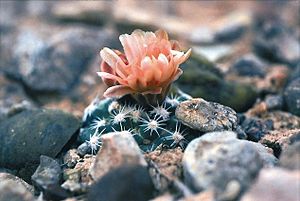Despain's cactus facts for kids
Pediocactus despainii, also known as Despain's cactus or San Rafael cactus, is a very rare type of cactus. It grows only in the state of Utah in the United States. Specifically, you can find it in a special area called the San Rafael Swell in Emery County. This cactus is so rare that it is listed as an endangered species by the United States government.
Quick facts for kids Despain's cactus |
|
|---|---|
 |
|
| Conservation status | |
| Scientific classification | |
| Kingdom: | |
| (unranked): | |
| (unranked): | |
| (unranked): | |
| Order: | |
| Family: | |
| Genus: | |
| Species: |
P. despainii
|
| Binomial name | |
| Pediocactus despainii S.L.Welsh & Goodrich
|
|
Contents
Discovering Despain's Cactus
This unique cactus was first found in 1978 by a person named Kim Despain. Scientists officially described it in 1980. It was named after its discoverer.
Sometimes, people thought it might be a type of Pediocactus bradyi. However, most scientists now agree that Pediocactus despainii is its own separate species. It often grows near its closest relative, Pediocactus winkleri.
How Many Are Left?
There are only two main groups, or populations, of Despain's cactus left in the world. Together, these two groups have about 6,000 individual plants. Because there are so few, it is very important to protect them.
What Does Despain's Cactus Look Like?
This cactus is usually shaped like an egg or is somewhat rounded. It can grow up to 6 centimeters (about 2.4 inches) tall. It can also be about 9 centimeters (about 3.5 inches) wide. Most of the time, it does not have any branches.
Hiding from the Weather
One cool thing about this cactus is how it deals with tough weather. When it gets dry or cold, the cactus shrinks. It can even disappear underground! This makes it very hard to find for most of the year. It's like it's playing hide-and-seek with the world.
Spines, Flowers, and Fruit
- Spines: Each little bump on the cactus, called an areole, has up to 15 smooth, white spines. These spines are only a few millimeters long.
- Flowers: The plant produces pretty flowers that can be up to 2.5 centimeters (about 1 inch) long and wide. Their petals are usually yellowish or pinkish. The outer petals often have cool purple stripes down the middle.
- Fruit: After the flower, a green fruit grows. It ripens to a reddish color. The fruit is about a centimeter (0.4 inches) long and wide.
Where Does Despain's Cactus Live?
This special cactus grows in the San Rafael Swell in central Utah. This area is a very unique place with interesting rock formations. It's known for having many rare plants that grow only there. This means the area has a high rate of endemism.
Its Home in the Rocks
The cactus grows in soil made from limestone and siltstone. This soil comes from two specific rock layers called the Carmel Formation and the Moenkopi Formation. The area where it lives is mostly grassland. You might also see some juniper trees and pinyon pine trees growing nearby.
Why Is This Cactus Endangered?
Despain's cactus faces several dangers from human activities. These activities make it harder for the cactus to survive and grow.
- Poaching: Some people illegally dig up and take these rare cacti from their natural homes. This is called poaching.
- Off-Road Vehicles: Vehicles like ATVs and dirt bikes can drive off marked trails. This can damage the cactus plants and their habitat.
- Mining: Companies sometimes dig for minerals like gypsum in the area. This mining can destroy the places where the cactus grows.
- Petroleum Exploration: Searching for oil and gas can also harm the cactus's habitat. This includes activities like drilling or building roads.
Protecting the San Rafael Swell and educating people about this cactus are important steps to help it survive.
See also
 In Spanish: Pediocactus despainii para niños
In Spanish: Pediocactus despainii para niños


